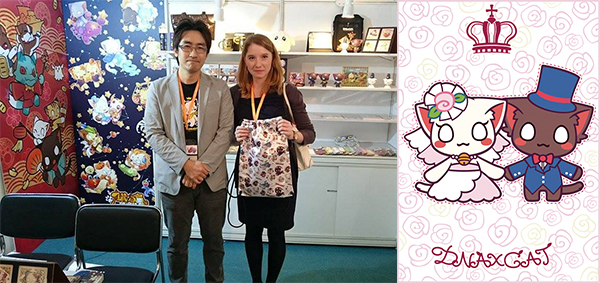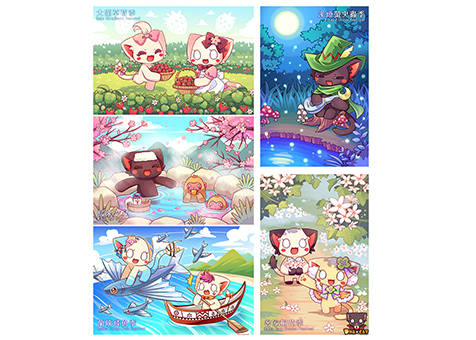7 December 2016

DNAxCAT’s founder, Chen Chung Chun (left), is a cat lover. The brand uses a black cat and a white cat as the cat characters’ basic design.

In recent years, DNAxCat has combined original Taiwanese designs with elements of the Taiwanese culture, including its cuisines, sights and local stories, to create cat designs with depth and historical meaning.
With 14 years of history, Taiwanese animation company DNA×CAT has amassed tens of thousands of active members on its online forum. Its businesses now include online games, animation and even music and other merchandises. But it was through exhibiting and developing its licensing business in Hong Kong that the brand found an opportunity to expand overseas.
Amber Ying, DNAxCat Co. Ltd.’s Vice President, said the company was not familiar with the licensing business in the beginning. It was by chance that she came across the Hong Kong International Licensing Show. “It was not only our first time joining the Licensing Show, it was also our first foray into the licensing business.”
Ying said that the company has also been joining the Hong Kong Gifts and Premium Fair and gradually met more buyers through the two fairs and gained more businesses. This year, the brand entered into a cooperation agreement with Taiwan’s Color & Character Co., Ltd. during the Hong Kong International Licensing Show for the latter to use DNAxCAT’s images on playing cards, which are popular with children and sold at convenience stores in Taiwan.
Injecting life into virtual characters
DNAxCAT’s founder, Chen Chung Chun, is a cat lover. Ying said: “The original idea was to have an online forum for cat lovers to come together. It was only afterwards that we decided to design a mascot for the website, which became the early form of the DNAxCAT character. At first, the brand only designed images for active members, but it later accumulated tens of thousands of members and launched different merchandises.”
Ying added that the brand uses a black cat and a white cat as its basic design and creates new characters based on the personalities and interests of actual members. She said: “DNAxCAT has always used anthropomorphic cats to connect with consumers, enterprises and products and to give life to the characters. Consumers buy the products not just out of their love of the characters’ looks, but for a recognition with and appreciation of the brand’s identity and the characters’ personalities.”
Connecting with the lives of target consumers for resonance
Ying acknowledged that images alone are not enough to attract consumers. “In Taiwan, more than half of the original brands that have existed for more than a decade have complete backstories.” She said DNAxCAT not only has a complete backstory and a variety of characters, it also has a rich worldview. “As we target young consumers, our stories and characters are closely related to this demographic. We play a role in the lives of these consumers.”
She said that the brand is feline-centric and has an affable image. The characters are also distinctive, which makes it easy for consumers to identify with them. “This is unlike some virtual image brands that are very removed from the consumers’ lives. Many of our fans identify with the characters and care for them, even taking it upon themselves to promote and defend the characters’ image.” Ying believes that everyone needs products that bring joy and relaxation to their busy lives. “Our brand often puts out messages related to charity or travel. This adds to the brand’s positive image and makes it easily accepted.”
In recent years, the brand has strived to enhance its brand awareness at home and abroad. To do that, DNAxCat has combined original Taiwanese designs with elements of the Taiwanese culture, including its cuisines, sights and local stories, and created cat designs with depth and historical meaning. The brand hopes that these distinctive qualities can attract attention and promote Taiwan’s multifaceted culture.
Continued exhibition instills confidence in overseas buyers
Ying said that Hong Kong is home to Asia’s largest and most reputable trade fairs. “Hong Kong is special in that ‘international fusion’ is a part of its culture. This is the reason why we have chosen the Hong Kong International Licensing Show for our first overseas exhibition.” She noted that the buyers she met at the fair were also from Taiwan. “We did not have the chance to meet them in Taiwan, and yet we get to discuss cooperation here in Hong Kong.”
Ying commended the HKTDC’s large buyer database. “Identifying European and US buyers through the database can be very quick. We have also benefited from the great synergy between trade fairs. Trade fairs of similar nature are often held at the same time, which is great for attracting a variety of buyers.” Ying said that to develop international markets, her brand needs to be recognised by more consumers, and that calls for overseas exhibition. “It also requires ‘continued exhibition’, as buyers often observe before they commit. If they see a brand multiple times at events, they will consider the brand stable and may place orders as a result.”
DNAxCAT will be exhibiting at the Taiwan Pavilion at the Hong Kong International Licensing Show next January. Multiple overseas and local ODM brands and properties will be featured at the event to promote the business opportunities that licensing brings.


